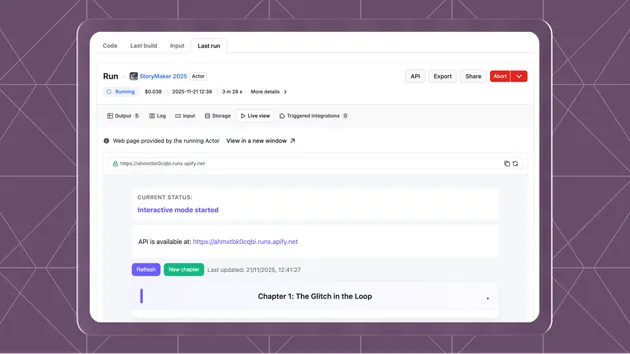Dataset Schema Super Actor
Pricing
Pay per usage
Pricing
Pay per usage
Rating
0.0
(0)
Developer

Zuzka Pelechová
Actor stats
0
Bookmarked
1
Total users
0
Monthly active users
18 days ago
Last modified
Categories
Share
Dataset Schema SuperActor
An automated Apify Actor that streamlines the creation of dataset schemas for Apify Actors. This SuperActor takes you through a complete workflow from input generation to GitHub pull request creation.
Overview
The Dataset Schema SuperActor generates, enhances, validates, and deploys dataset schemas for Apify Actors. It automates the entire lifecycle of dataset schema creation, ensuring consistency and quality across your Actor projects.
Five Core Steps
The Actor operates in five sequential steps, each of which can be enabled or skipped based on your needs:
📝 Step 1: Generate Test Inputs
This step uses Claude Sonnet 4 to generate four types of test inputs for your Actor:
- Minimal Input: Basic input with only essential parameters
- Normal Input: Realistic input with common optional parameters
- Maximal Input: Comprehensive input utilizing all available parameters
- Edge Input: Input designed to test error handling while still producing a dataset
The generated inputs are validated against the Actor to ensure they work correctly before proceeding.
When to use:
- You don't have existing test inputs
- You want to generate comprehensive test coverage automatically
- You're testing a new Actor
📊 Step 2: Generate Initial Schema
This step creates a base dataset schema. You have three independent options:
Option A: Generate Inputs First (Step 1)
- Enable Step 1 to auto-generate test inputs
- The Actor runs with these generated inputs
- Schema is extracted from the output datasets
Option B: Provide Your Own Inputs
- Set
generateInputs: false - Provide
existingMinimalInput,existingNormalInput,existingMaximalInput,existingEdgeInput - The Actor runs with your provided inputs
- Schema is extracted from the output datasets
Option C: Use Real Production Datasets
- Set
generateInputs: falseanduseRealDatasetIds: true - The Actor queries Redash to find recent datasets for your Actor
- Samples data from real production runs
- Schema is generated from actual user data (no Actor runs needed)
The schema generator Actor analyzes the structure of items in the datasets and creates a JSON Schema definition.
When to use:
- Option A: You want everything automated
- Option B: You have proven test inputs that work
- Option C: You want the most realistic schema based on actual usage patterns
✨ Step 3: Schema Enhancement
This step uses Claude Sonnet 4 to improve the initial schema by:
- Adding clear field descriptions
- Generating realistic, anonymized examples
- Ensuring proper field types and formats
- Creating dataset views (if enabled)
- Making all fields nullable by default
Important: All fields start as nullable. After the Actor generates the enhanced schema, developers can review it and choose which fields should:
- Not be nullable (required for schema validation)
- Be added to the
requiredarray - Have stricter type constraints
The enhancer works with the existing schema structure and only improves the content—it doesn't add, remove, or rename fields.
When to use:
- You want a production-ready schema with documentation
- You need dataset views for better visualization
- You want to improve existing schema quality
🔍 Step 4: Schema Validation
This step queries Redash to find datasets from recent Actor runs and validates them against the schema:
- Fetches datasets from the last N days (configurable)
- Samples data from each dataset
- Validates data structure against the schema
- Reports validation success rate and any errors
Validation ensures the schema accurately represents real Actor output data. It requires a 100% success rate before proceeding to PR creation.
When to use:
- You want to verify schema accuracy against real data
- You need to catch schema issues before deploying
- You want confidence that the schema works with production data
📝 Step 5: GitHub PR Creation
This step automates the GitHub workflow:
- Finds the target Actor's repository (supports monorepo structures)
- Locates the correct
actor.jsonfile in the actor's directory - Creates a new branch
- Generates
dataset_schema.jsonwith field definitions and views - Moves existing views from
actor.jsontodataset_schema.json(if they exist) - Updates
actor.jsonto reference the schema - Creates a pull request
When to use:
- You want to deploy the schema to your Actor repository
- You need an automated PR workflow
- You're ready to integrate the schema into your codebase
GitHub Token Permissions Needed:
repo- Full control of private repositoriesworkflow- Update GitHub Action workflows (if applicable)
💸 Pricing & Costs
You pay for this Actor’s own runtime and for any background Actors it launches. In practice, the end-to-end workflow is very inexpensive:
- Typical runs: well under $0.10 total.
- Larger runs (more datasets, longer validation windows): usually below $1.
Actual cost depends on factors like number/size of datasets sampled, whether inputs are generated, LLM usage (Claude Sonnet 4), and how many validation checks you run.
Cost controls
- Reduce
daysBackandmaximumResultsduring validation. - Disable steps you don’t need (
generateInputs,validateSchema,createPR).
Note: Background Actors are billed separately under your Apify account, and LLM usage (e.g., Claude Sonnet 4) is billed via your configured API key if applicable.
Usage Examples
Full Workflow
Generate everything automatically from scratch:
Using Your Own Inputs
Skip input generation and use your own test inputs:
Using Real Production Datasets
Generate schema from production data instead of test inputs:
Schema Enhancement Only
Enhance an existing schema without running any Actors:
Skip PR Creation
Generate and validate schema without creating a PR:
Workflow Output
The Actor provides detailed progress information for each step:
Technical Details
Schema Format
The Actor generates schemas following the Apify Actor specification format:
Dataset Views
Views are generated automatically when generateViews: true:
- Overview view with all fields in table format
- Field formatting based on type (image, link, date, number)
- Proper field labels from camelCase
- Existing views are moved from
actor.jsontodataset_schema.json
GitHub Integration
The Actor:
- Searches for Actor-specific
actor.jsonfiles in monorepo structures - Supports path patterns like
actors/[actor-name]/.actor/actor.json - Moves existing views from
actor.jsonto the newdataset_schema.json - Updates
actor.jsonto referencedataset_schema.jsonvia thestorages.datasetfield - Preserves existing formatting and structure
Support
For issues, questions, or contributions:
- Check the Actor logs for detailed error messages
- Review each step's output in the progress tracking
- Open an issue (or better yet a PR) in the repository


